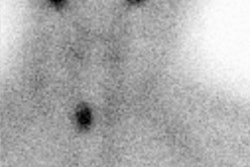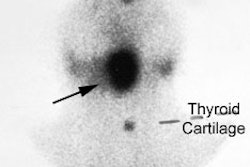J Nucl Med 2001 Jul;42(7):1084-90
Improved prediction of therapeutic absorbed doses of radioiodine in the
treatment of thyroid carcinoma.
Hermanska J, Karny M, Zimak J, Jirsa L, Samal M, Vlcek P.
We proposed an alternative to a monoexponential model of radioiodine kinetics to
obtain a more accurate estimate of absorbed doses to postsurgical thyroid
remnants. We suggested that part of the difference between the predicted and the
actually absorbed therapeutic doses of (131)I, usually explained by radiation
damage of thyroid cells, can be attributed to errors resulting from inadequate
sampling of data and oversimplified modeling. METHODS: A standard
monoexponential model and alternative biphasic model (incorporating both
radioiodine uptake and clearance) were used on 2 sets of patient data to fit
time-activity measurements after administration of diagnostic and therapeutic
activities of radioiodine. One set of data consisted of 633 records of routine
measurements, and the second set consisted of 71 prospectively collected records
with measurements performed more frequently and for a longer time. The
time-activity curves derived from the 2 models were used to calculate residence
times for diagnostic and therapeutic activities of (131)I, and the respective
residence times were compared using the paired t test. Errors of fitting and
prediction of therapeutic time-activity data were also calculated. RESULTS: With
both models, a statistically significant difference (P < 0.01) was found
between residence times after diagnostic administration of (131)I and residence
times after therapeutic administration of (131)I. However, the effects of
biphasic modeling and of improved sampling substantially reduced the difference
(P < 0.01). Errors of fitting and prediction were smaller with the biphasic
model than with the monoexponential model (P < 0.01). CONCLUSION: The
biphasic model more accurately predicts (131)I kinetics when applied to
measurements in the short interval after diagnostic administration of
radioiodine. The minimum requirement for the biphasic model is measurement twice
a day at intervals > 6 h for at least 3 d after administration.




